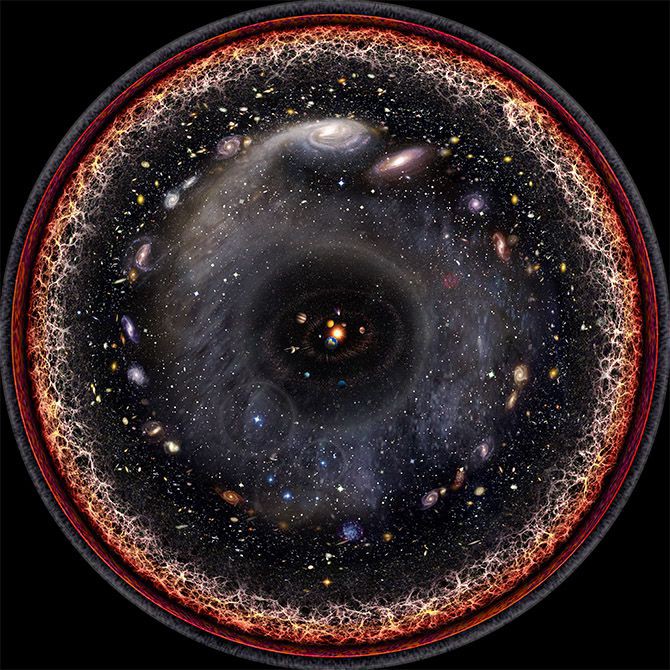
On the 26th of April 1920, scientists and members of the public piled into a crowded lecture hall to hear astronomy?s most legendary debate. The night?s motion: was our galaxy the only one? Arguing for the motion was the young and ambitious astronomer Harlow Shapley, and against it was his more senior Herbert Curtis of Lick Observatory.
Many of Shapley and Curtis? central points hinged upon observations of nebulae (the term used to apply to any diffuse astronomical object) and their distances from Earth. However, the data just weren?t there to come to a decisive conclusion.
Finding such data would take another three years, when Edwin Hubble observed a certain type of star called a Cepheid variable in one of the disputed nebulae. What made this so significant was that the brilliant ? yet sadly overlooked ? astronomer Henrietta Swan Leavitt had discovered a method of determining the intrinsic luminosity of a Cepheid by its period of dimming and brightening. Thus, by knowing a Cepheid?s period and the rate at which light from distant objects dims, you could calculate how far away it was. In this case, the Cepheid was measured to be 900,000 light-years away (later corrected to around 2.5 million light-years) ? in any case far outside the known radius of the Milky Way. Hubble excitedly scribbled ?VAR!? (as in ?variable?) over his observations, gaining fame for his discovery while never crediting Leavitt.
 6th of October 1923: Hubble makes his famous observation proving that our galaxy is but one of many.
6th of October 1923: Hubble makes his famous observation proving that our galaxy is but one of many.
Following in the long astronomical tradition of humbling our expectations of cosmic significance, Hubble?s discovery showed that Curtis was right. The universe was much bigger than we had imagined. But just how big?
Answering this would rely on another of Hubble?s results, this one made in 1929: that the universe is expanding. He realised this because the light emitted from distant celestial objects was redder than expected, due to a downward shift in their frequency as they receded from us. Since objects were getting further apart from each other, some scientists reasoned that there may have been some point in the past at which the whole universe was compressed into a single point. (It?s worth noting that other, more obscure, figures like Georges Lematre and Alexander Friedmann made many of these contributions, and so my crediting Hubble is a gross act of simplification.)
After a long period of tweaking theory to match experimental data, this approach allowed astronomers to measure the age of the universe at about 13.8 billion years. You would be forgiven for assuming that the problem was solved there, and that a reasonable definition of the ?observable universe? ? that part of the whole universe which we can theoretically see ? is a sphere with a radius of 13.8 billion light-years centred on the Earth. After all, that?s only as long as light has had to reach us. This is a very common misconception: it would only be true in a universe that was static, i.e. not expanding or contracting.
You see, Hubble found from his data that the distance to a given galaxy was proportional to its recessional velocity, with a constant of proportionality now known as the Hubble constant H. Extrapolating this forward, there is a sphere past which everything is travelling away from us faster than the speed of light. This is known as the Hubble Sphere, and it has a radius of around 15 billion light-years.
You wouldn?t be the first to worry that this faster-than-light travel violates Einstein?s theory of relativity, which says that nothing can travel faster than light. However, what relativity actually says is that matter within space can?t travel faster than light, but nothing about how fast space itself can travel. Much ado is made about the fact that during inflation (the extremely rapid period of expansion in the early universe) pieces of matter were travelling apart from one another faster than the speed of light, but in fact, that?s still happening now!
So, is the Hubble Sphere the solution to our problem? Is that the real observable universe? Not quite. The radius of the Hubble Sphere will be given by c/H, where c is the speed of light and H is the Hubble constant (take a second to think about why). Even though the discovery of dark energy in the 1990s showed us that the universe is not only expanding but accelerating in its expansion, the Hubble constant is actually decreasing ? and thus not a constant at all! The reason for this is that the Hubble constant (I wish there were a better name) is the relative velocity of two objects divided by their distance apart, and the expansion of space means that the bottom of the fraction is increasing faster than the top.
The upshot of this is that our Hubble Sphere is expanding. If the Hubble Sphere expands fast enough, light leaving an extremely distant object can get ?caught? and drop from the superluminal (faster-than-light) region outside the sphere to the subluminal (slower-than-light) region inside it. Once this light is within the Hubble Sphere, it can make its way to our telescopes. If you work out their present distance from us, it turns out that all of the photons we receive from the first five billion years of the universe?s existence were all caught by the Hubble Sphere. These objects were, are, and always will be travelling away from us faster than the speed of light!
All of this is to say that the boundary of distant objects we can theoretically observe is much further out than the Hubble Sphere. The full extent of the observable universe is bounded by the Particle Horizon, which is based on the time that light has had to travel to us since the beginning of the universe, taking into account its expansion. The Particle Horizon has a radius of a staggering 46.5 billion light-years, implying that the observable universe is 93 billion light-years across.
The matter responsible for the famous Cosmic Microwave Background (CMB) radiation, sometimes called the universe?s baby picture, is at the Particle Horizon, but its light has taken ?only? 13.8 billion light-years to reach us. In this case, we say that the comoving distance ? the actual distance from point A to point B ? is 46.5 billion light-years but the light-travel distance is 13.8 billion light-years. These two metrics would only be equal in a perfectly static universe.
Of course, we can only assume that the ?whole? universe extends far beyond the Particle Horizon. Saying that the universe is infinite is as much an act of ignorance as an act of extrapolation. At the end of the day, we have no idea. After all, how could we?
The Particle Horizon limits how far distant we can see, and the Hubble Sphere limits how far back in time we can see. We could never see objects outside the Hubble Sphere as they are now, no matter how long we waited. Moreover, just as light can get caught in the Hubble Sphere, the expansion of space can push light out of it. It?s estimated that we lose visibility of 20,000 stars a second because of this! In a few billion years, the observable universe will consist of only our ?local group? of a few dozen galaxies. It?s melancholic to think that future astronomers would look to the skies and gaze upon a barren universe. Perhaps they would look back at our astronomy magazines and be left to wonder what all the fuss was about.


